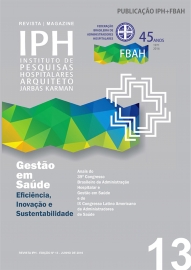Publications IPH Magazine IPH Magazine 13th: Annals Quality and Safety Integration on Education Process

- Editorial - 13th
- HEALTH MANAGEMENT: Efficiency, Innovation and Sustainability
- Health Management Focused on Efficiency, Innovation and Sustainability!
- CONGRESS FOR COST AND FINANCIAL MANAGEMENT
- Hospitals, networks and sustainability
- Cost Reduction through Process Review
- Integrating Business Management to the Assistance Management
- International experience on the compensation models
- The Future of Hospital System - The Sustainability Challenge of Small Hospitals
- Advances in Patient Safety: Indicators and Impact on Cost Assistance
- Prospects for Public Private Partnerships and the Partnership Arrangements with Health Social - Critical Analysis of the PPP Brazilian Experiences in Health
- ENGINEERING, ARCHITECTURE AND LOGISTICS CONGRESS
- Hospital Logistics: Intelligence at Service for the Health Manager
- PEOPLE MANAGEMENT AND LEADERSHIP CONGRESS
- Illusionist Performance: Transformation and Innovation in Tough Times
- Implementation Careers & Salaries: New Paradigms and Opportunities
- The Art of Leading Generations X, Y and Z - How to retain talent?
- Giving Back Over the Organizational Climate - Talent Retention Strategies
- Creative Practices to Innovate in HR
- HEALTH MANAGMENT CONGRESS
- Efficiency
- Efficiency (2)
- The Process of Change in Bolivia "Hospital Arco Iris" from Solid Hospital to Liquid Hospital
- PATIENT'S QUALITY AND SAFETY CONGRESS
- Impact of External Assessment in Brazil
- Impact of External Assessment in Brazil (2)
- Quality and impact of patient safety in the hospital financial result - Santa Casa de Misericordia de Maceió
- Quality and Safety Integration on Education Process
- Management
- The Apthapi as Innovation Strategy in the Humanization of Healthcare Hospitality
- The experience of the State Hospital Sumaré / Unicamp in management by care
- HOSPITAL HOTEL CONGRESS
- Hospitality in Patient Perspective
- Hospitality at the Service of Humanization
- Hospitality and Humanization
- Hospitals Infrastructure Trends aimed at Physical and Mental Comfort for Patients and Families
- The Multidisciplinary Integration of Beds Management as a Way to Seek Effectiveness
- Spirituality in Hospitals Focusing on Healthcare Hospitality
Quality and Safety Integration on Education Process
Sonia Regina Pereira, Rita Simone Lopes| Moreira, Fernanda Amaral R. Chaves
Sonia Regina Pereia
Ordinance MS / GM No. 529/2013 establishes a set of basic protocols defined by the WHO. Two issues prompted the WHO to elect these protocols: the small investment required for its implementation and the magnitude of the errors and adverse events resulting from the lack of them. Progress in health is accompanied by the rise of technology, requiring professionals working in this sector, the search for knowledge continued, so there is a balance between these in patient care.
The International WHO Patient Safety Rating aims to provide a comprehensive understanding of the field of patient safety. It aims to represent a cycle of learning and continuous improvement, enhancing the identification, prevention, detection and risk reduction; recovering the incident and resilience of the system. Learning and improving the quality should permeate the health system complexities that are connected with the various sources of information and the different fields of expertise among professionals, staff, patients and technology.
Many researchers have proposed that the strategies for patient safety should follow the models used in aviation and the nuclear power industry, believing that it will achieve the same success. However, the reality is probably more complex.
Patient safety promotion movement in health services begins to make sense when it is put on practice, i.e., it ceases to be a project or a regulation to meet the learning process steps of recommendations for managers, or to the databases of those responsible for risk management and is constituted as a change of culture that is based on the attention to the patient and his family.
Accepting the transition from craftsman mentality (my patient) by professionals in the same category is one of the barriers to be overcome by the team that provides services.
The creation of a secure system involves normalizing the activity of various professionals, so that the quality does not suffer inappropriate variations. To reach the next level of safety, health professionals must face a very difficult transition, leaving their status and self-image of being the artist who single-handedly is responsible for the outcome and, instead, adopt a position that values the equivalence between the different professionals who work in the health system. Creating a culture of safety drives professionals to be responsible for their actions through a proactive leadership, which enhances the understanding and explain the benefits, ensuring impartiality in the treatment of adverse events, without taking punishment measures against the occurrence of the same.
In a review and meta-analysis, researchers critically examined the literature to identify studies that pointed the importance of beliefs, attitudes and behaviors that are part of the safety culture in hospitals. Identified several properties, which organized in seven subcultures as described: Leadership, Teamwork, Communication, Learning from mistakes, Justice, Care patient-centered and evidence-based practice. The teaching of this content among all health professionals can be an essential key for everyone to be and feel responsible for the provision of safe care. The inclusion of this content as required in the formation of multi-resident can promote the construction of critical professional and unison in this practice.
Residency General Coordinator in Health / Education Development Board Health / SESu / MEC, Assistant Professor / Department of Pediatric Nursing / Paulista School of Nursing / UNIFESP.
Send by e-mail:


